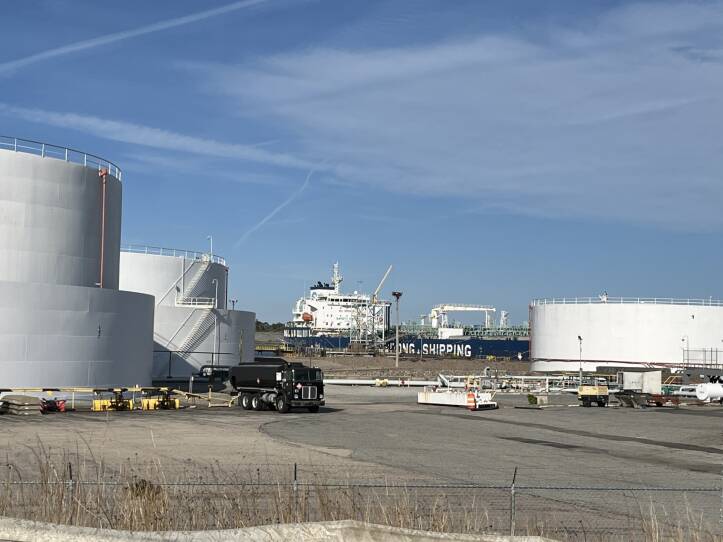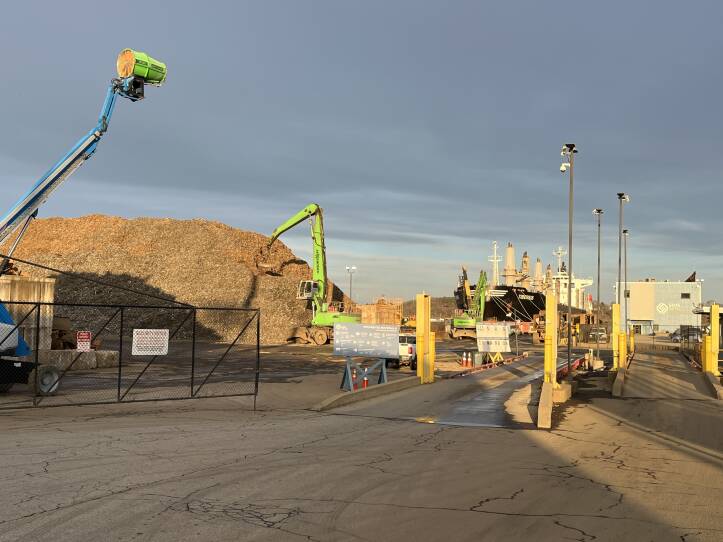Monica Huertas and her husband wanted to move to Providence’s Washington Park because it was the only neighborhood they could afford. Once homeless, they now had jobs in social work and construction, and they were ready to have a place of their own.
When they finally found a home they liked nine years ago, they hired an inspector to make sure everything in the house was up to par. But missing from that inspection were external factors that have since reshaped the family’s lives: polluters from the nearby Port of Providence.
“Look at the cumulative impacts,” said Huertas, whose family of six all suffer from asthma. “What does tar, cement, oil, gas ... trucks in and out, idling, do to us? How does that affect all of us?”
She said her 8-year-old suffers from Kawasaki disease, an inflammation in the arteries, and has spent long stretches in the hospital. Recent medical studies have pointed to air pollution as a contributing factor of this childhood heart disease.
“The crazy chemicals that we have here, particulate matters in the air, depending on how it blows. That’s all linked to this disease my son has,” Huertas said, her sentences interrupted by frequent coughing.
Washington Park is an environmental justice community with 63% people of color and nearly half low-income. Toxic air releases here are among the worst in Rhode Island, according to EPA tracking. The neighborhood also ranks in the 94th percentile statewide for proximity to facilities using and storing extremely hazardous materials, some transported by cargo ships.
Residents are constantly exposed to emissions from ships burning dirty bunker fuel, diesel exhaust from trucks, chemical fires and pervasive odors from asphalt plants and metal recyclers.
Port communities along Boston Harbor face similar health impacts. But in Boston, the response from local environmental justice groups and city and state government agencies has been muted, lagging or focused on other pollution issues despite a resurgent shipping industry since the pandemic, a GBH News investigation earlier this year found.
Not so in Providence.
Even though its marine ports see only about a third of the oceangoing vessel traffic as Boston, community activists there are galvanized. They’re rallying neighbors — and gaining traction — in their fight against port-related pollution with policymakers, regulators and university researchers.
A preemptive, door-to-door campaign
“What we do is old-school door-knocking,” said Huertas.
When a neighbor opens their door, Huertas said her first question is whether they have asthma.
“And then the second thing is, 'When you open your windows or when you walk out of your house, do you smell something?’” she said.
Since 2019, a groundswell of activism has prodded Providence and Rhode Island officials, along with Brown University, to conduct two air quality projects around the port.
Activism has also spurred agencies to count truck traffic, hold community meetings and reject the expansion of a liquid petroleum gas facility.

The Rhode Island attorney general has gone after a port-based metal recycler for environmental violations. And a grant-funded project just partnered with a phone app that encourages residents to report noxious odors around the port.
“The amount of activism we’ve had ... and the politicians and folks that have been brought into the conversation around the port of Providence, it’s almost impossible to ignore as a problem,” said Rhode Island Sen. Tiara Mack, who represents part of Washington Park.
"Part of it is us being in their faces all the time."Monica Huertas, activist
The Port of Providence and the industries that rely on its big cargo and tanker ships flank much of Allens Avenue on the south side of the city and just east of I-95. Mountains of rusty scrap metal lie behind tall fences. Truck traffic is nearly constant along this four-lane street. And the ship traffic to Providence’s port area saw a big boost in 2023, with tonnage up 28% from the pre-pandemic averages, according to U.S. Customs data obtained by the GBH News Center for Investigative Reporting.
“People don’t pay a lot of attention to that industry until there is a fire or an explosion or some disaster,” said April Brown, director of the Racial and Environmental Justice Committee, a nonprofit that got its start under Providence’s Office of Sustainability.
Organizers like Brown and Huertas made sure that when Providence drafted its climate justice plan in 2019, the impact of port pollution on Washington Park was emphasized.
Preparing for an influx of federal dollars
Now, a massive amount of federal dollars from the Biden administration is poised to address infrastructure and clean technology, including at ports — an opportunity that has heightened the activists’ urgency.
“We’re working with Department Environmental Management. We’re working with the city [of] Providence ... because there’s a lot of money coming down,” said Huertas. “A lot of the technology is not even available here to electrify the entire port. It would be really really hard. But we’re definitely as community willing to do whatever we can to make sure that that happens. And part of it is us being in their faces all the time.”

A scrap metal recycler on the port, Sims Metal, recently took a small step toward electrification by replacing its diesel-powered car flattener with an electric one.
“You’re in the limelight here,” said Sims operations director Mike Kiwanis, noting the public visiblity of the Providence scrapyard. “So we try to do the right thing and contribute to the decarbonization.”
The electric car flattener is expected to reduce the site’s carbon emissions by more than nine tons a year. Kiwanis said the company is also buying two electric forklifts and an electric excavator in the coming months — all part of trying to meet the state’s net-zero emissions goal by 2050.
Julian Drix, a public health expert and community organizer who also lives in Washington Park, welcomes any electrification in the port. At the same time, he’s skeptical about port businesses pointing to just a few environmental initiatives to avoid taking responsibility for bigger problems.
While waiting for his two kids by a basketball court near the port, he recalled how there had just been a big fire at another scrapyard on the port, Rhode Island Metal Recyclers.
“A raging fire. Hundred-foot flames, towering plume of black smoke. The wind happened to be blowing from the east, so it went right over our neighborhood,” he said.
Drix is now pushing the city to align its zoning with climate goals for Washington Park, envisioning a future where polluters can no longer operate here once their leases expire. That would also create more room for businesses connected to Revolution Wind, a wind farm under construction 15 miles off the Rhode Island coast.
“There is a huge amount of work being done right around the corner. We can see it from here — their ships that are loading up finished components for the turbines,” he said. “I’m really hoping that all the money to be made expanding offshore wind will be what we need to actually get rid of the hazards in this community once and for all.”

An app asks: What do you smell?
The environmental and health hazards around the Port of Providence remain very much in the faces — and nostrils — of local residents.
Breathe Providence, a grant-funded project based at Brown University, is using low-cost sensors to measure air quality around the port. It’s focusing on the pervasive odors from volatile organic compounds that so many residents have complained about.
They’ve also partnered with a phone app called Smell MyCity, developed by Carnegie Mellon University but expanded for Providence, to allow users to rank the odor on a scale of one to five, name their health symptoms and describe the odor.
“It can give shape to the problem and the extent. We can use that data [to] make moves on mitigation and compliance,” said Grace Berg, the project coordinator at Breathe Providence.
You want to open your windows because it’s like a beautiful day and let the fresh air in. And then it’s that disgusting pungent gas, oily-like smell.Monica Huertas, activist
Huertas said noxious smells around the port also have a huge impact on people’s mental health and quality of life.
“You want to open your windows because it’s like a beautiful day and let the fresh air in. And then it’s that disgusting pungent gas, oily-like smell,” she said. “So you close the windows again and then you’re sad.”
But activists like Huertas cling to optimism for transforming this polluted port, making some of it accessible for recreation, even if it’s just a 25-foot wide strip of coastline surrounded by heaps of rusted metal and mountains of road salt.
For years, this lane off Allens Avenue was off-limits, the waterline fenced off. Huertas said neighborhood organizers pushed state agencies for two years to recognize this piece of coastline as public.
“We had to fight tooth and nail,” she said.
It’s a foothold, meant to inspire more activism.
“We’re going to have trees. We’re going to have it walkable and actual road benches, lighting, some cool art,” Huertas said. ”And we’re going to have a dock there so people could fish.”
This story was supported by the Pulitzer Center.





